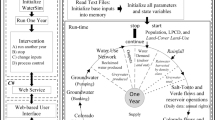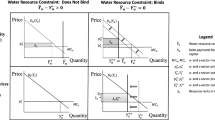Abstract
Climate change is likely to result in increased aridity, lower runoff, and declining water supplies for the cities of the Southwestern United States, including Phoenix. The situation in Phoenix is particularly complicated by the large number of water providers, each with its own supply portfolio, demand conditions, and conservation strategies. This paper details spatial optimization models to support water supply allocation between service provider districts, where some districts experience deficits and others experience surpluses in certain years. The approach seeks to reconcile and integrate projections derived from a complex simulation model taking into account current and future climate conditions. The formulated and applied models are designed to help better understand the expected increasingly complex interactions of providers under conditions of climate change. Preliminary results show cooperative agreements would reduce spot shortages that would occur even without climate change. In addition, they would substantially reduce deficits if climate change were to moderately reduce river flows in Phoenix’s major source regions, but have little effect under the most pessimistic scenarios because there are few surpluses available for re-allocation.





Similar content being viewed by others
References
Arizona Department of Administration (2011a). http://www.workforce.az.gov/census-data.aspx (Last accessed October 31, 2011).
Arizona Department of Administration (2011b), http://www.workforce.az.gov/population-projections.aspx (Last accessed November 1, 2011).
Barnett TP, Pierce DW (2008) When will Lake Mead go dry? Water Resour Res 44:W03201. doi:10.1029/2007WR006704
Barros MTL, Zambon RC, Barbosa PSF, Yeh WWG (2008) Planning and operation of large-scale water distribution systems with preemptive priorities. J Water Resour Plann Manag 134(3):247–256
Becker N (1995) Value of moving from central planning to a market system: lessons from the Israeli water sector. Agric Econ 12(1):11–21
Brill E, Hochman E, Zilberman D (1997) Allocation and pricing at the water district level. J Agric Econ 79(3):952–963
Christensen NS, Lettenmaier DP (2007) A multimodel ensemble approach to assessment of climate change impacts on the hydrology and water resources of the Colorado River basin. Hydrol Earth Syst Sci 11:1417–1434
Christensen NS, Wood AW, Voisin N, Lettenmaier DP, Palmer RN (2004) The effects of climate change on the hydrology and water resources of the Colorado River Basin. Clim Chang 62:337–363
Ellis AW, Hawkins TW, Balling RC, Gober P (2008) Estimating future runoff levels for a semi-arid fluvial system in central Arizona, USA. Clim Res 35(3):227–239
Enke S (1951) Equilibrium among spatially separated markets: solution by electricanalogue. Econometrics 19(1):40–47
Enright C, Lund JR (1991) Alternative water-district organization:screening-level analysis. J Water Resour Plann Manag 117(1):86–107
Garrido A (2000) A mathematical programming model applied to the study of water markets within the Spanish agricultural sector. Ann Oper Res 94:105–123
Gober P (2006) Metropolitan Phoenix: place making and community building in the desert. University of Pennsylvania Press, Philadelphia
Gober P, Kirkwood CW (2010) Vulnerability assessment of climate-induced water shortage in Phoenix. Proc Natl Acad Sci 107(50):21295–21299
Gober P, Kirkwood CW, Balling RC, Ellis AW, Deitrick S (2010) Water planning under climatic uncertainty in Phoenix: Why we need a new paradigm. Ann Assoc Am Geogr 100:1–16
Gober P, Wentz EA, Lant T, Tschudi MK, Kirkwood CW (2011) WaterSim: a simulation model for urban water planning in Phoenix, Arizona, USA. Environ Plann B 38:197–215
Guise JWB, Flinn JC (1970) The allocation and pricing of water in a riverbasin. Am J Agric Econ 52(3):411–421
Jinfeng W, Jilei W, Zhiyong W, Changming L, Jingjie Y (2004) An optimized spatial-temporal-sectoral allocation model for water resources. GeoJournal 59(3):227–236
Lempert RJ, Popper SW, Bankes SC (2003) Shaping the next one hundred years: New methods for quantitative, long-term policy analysis. Santa Monica, CA: RAND Corporation
Marin CM, Smith MG (1988) Water resources assessment: a spatial equilibrium approach. Water Resour Res 24(6):793–801
Milly PCD, Betancourt J, Falkenmark M, Hirsch RM, Kundzewicz ZW, Lettenmaier DP, Stouffer RJ (2008) Stationarity is dead: whither water management? Science 319:573–574
National Research Council (2007) Colorado River Basin water management: Evaluating and adjusting to hydroclimatic variability. Washington, DC: National Academies Press
Sampson DA, Escobar V, Tschudi MK, Lant T, Gober P (2011) A provider-based water planning and management model - WaterSim 4.0 - for the Phoenix Metropolitan Area. J Environ Manag 92:2596–2610
Samuelson PA (1952) Spatial price equilibrium and linear programming. Am Econ Rev 42(3):283–303
Seager R, Ting M, Held I, Kushnir Y, Lu J, Vecchi G, Huang H, Harnik N, Leetmaa A, Lau N, Li C, Velez J, Naik N (2007) Model projections of an imminent transition to a more arid climate in southwestern North America. Science 316:1181–1184
Takayama T, Judge GG (1964) Spatial equilibrium and quadratic programming. J Farm Econ 46(1):67–93
Vaux HJ, Howitt RE (1984) Managing water scarcity: an evaluation of interregional transfers. Water Resour Res 20(7):785–792
Wentz EA, Gober P (2007) Determinants of small-area water consumption for the City of Phoenix, Arizona. Water Resour Manag 21:1849–1863
Yang W, Yang ZF (2010) An interactive fuzzy satisfying approach for sustainable water management in the Yellow River Delta, China. Water Resour Manag 24(7):1273–1284
Acknowledgements
This article is based on work supported by the National Science Foundation under Grant No. SES-0345945, Decision Center for a Desert City. Any opinions, findings, and conclusions or recommendations expressed in this material are those of the authors and do not necessarily reflect the views of the National Science Foundation.
Author information
Authors and Affiliations
Corresponding author
Rights and permissions
About this article
Cite this article
Murray, A.T., Gober, P., Anselin, L. et al. Spatial Optimization Models for Water Supply Allocation. Water Resour Manage 26, 2243–2257 (2012). https://doi.org/10.1007/s11269-012-0013-5
Received:
Accepted:
Published:
Issue Date:
DOI: https://doi.org/10.1007/s11269-012-0013-5




